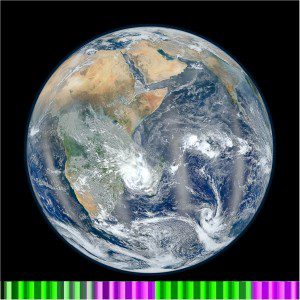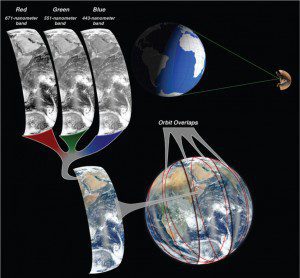
This image of Earth's eastern hemisphere was built from data collected by NASA's Suomi NPP satellite. As shown in the inset below, separate images in red, green and blue wavelengths are combined to make natural-color imagery. Multiple, adjacent swaths”slices of Earth viewed on each satellite pass”get built into the composite image.
People love images of the full disk of Earth as it would appear from space. NASA science colleague Norman Kuring recently took some fresh data from the agency's newest Earth observation satellite, projected them onto a disk and voila”3 million people viewed the image in a week!
 The above image of Earth's eastern hemisphere was built from data collected by the Suomi National Polar-Orbiting Partnership (NPP) satellite, which flies in a polar orbit at an altitude of 824 kilometers (512 miles). The perspective of this new image, however, is from 12,743 kilometers (7,918 miles) above a point at 10 degrees south latitude and 45 degrees east longitude.
The above image of Earth's eastern hemisphere was built from data collected by the Suomi National Polar-Orbiting Partnership (NPP) satellite, which flies in a polar orbit at an altitude of 824 kilometers (512 miles). The perspective of this new image, however, is from 12,743 kilometers (7,918 miles) above a point at 10 degrees south latitude and 45 degrees east longitude.
Kuring managed to step back from Earth by combining data from six separate orbits NASA's Suomi NPP
made on Jan. 23, 2012. The natural-color images come from the satellite's Visible Infrared Imaging Radiometer Suite (VIIRS). The four vertical lines of haze are caused by sunglint, the reflection of sunlight off the ocean.
The inset graphic illustrates how separate images in red, green and blue wavelengths are combined to make natural-color imagery, and how multiple, adjacent swaths”slices of Earth viewed on each satellite pass”get built into a composite. The width of the swaths covered by each pass of VIIRS is about 3,001 kilometers (1,865 miles).
A decade ago, members of NASA's Earth Observatory team pulled together about 10,000 satellite scenes, collected over 100 days, and created a 43,200- by 21,600-pixel map of Earth. By 2007, the resolution of this full Earth Blue Marble was up to 86,400 pixels by 43,200 pixels. Even after all of these years, the Blue Marble is still the most popular and most downloaded NASA image.
Of course, the original Blue Marble image is actually a photograph”not a composite view. It was taken by the Apollo 17 astronauts as they traveled to the moon. The view is from a distance of about 45,000 kilometers
(28,000 miles).

